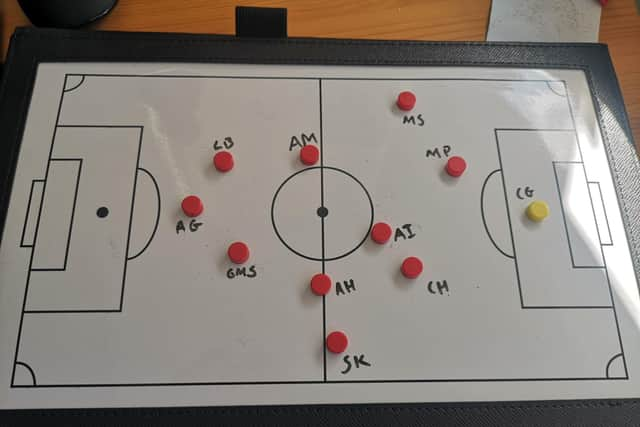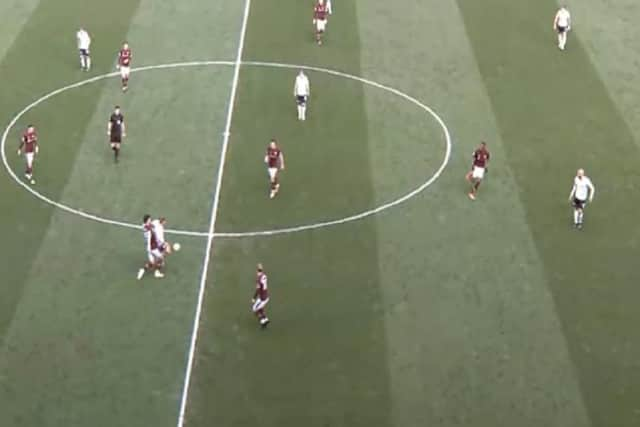How Hearts benefited from diamond v Dundee - and how it can work going forward


He has spoken this week about changes to the team in the coming weeks with cup suspensions and international call-ups on the horizon.
Before then, the Championship league leaders have a home fixture with Ayr United and a trip to Arbroath as they look to move closer to the title and a return to the Premiership.
Advertisement
Hide AdAdvertisement
Hide AdLooking back to the win over Dundee we assess the effectiveness of the system.
The big takeaway from the fixture was the front two, Neilson keen to get Liam Boyce and Armand Gnanduillet into the same team. It helped the team be more direct with bodies getting forward in support. They weren’t overly fussed about playing through midfield and didn’t waste much time playing it around at the back either. Mihai Popescu and Craig Halkett exchanged just nine passes all game.
Encouraging signs
Gnanduillet was key and displayed how astute a signing he could be.
The Frenchman was a constant option and worked himself into areas where he could help team-mates, both aerially and on the deck.
Advertisement
Hide AdAdvertisement
Hide Ad

He chased his own flick-on early on, he knocked the ball down for Boyce from a throw-in, played in Aaron McEneff with a first-time lay off. Even from clearances from deep he can make something out of nothing due to his size and control, relieving pressure.
There are so many encouraging facets to his game but his willingness to move horizontally and vertically makes a massive difference. Dundee were sent a warning in the 28th minute when he pulled into a wide position and set up Boyce for a shot.
Then the goal. Another example of two-man strike threat with both forwards happy going into wide areas. Gnanduillet again drifted wide to get on to an excellent Smith pass. His cross missed Boyce but was netted by Halliday.
It was a deserved goal and owed to the willingness of players to get into the box. On various occasions the home side flooded the box with players (Image 2 & 3). Dangerous crosses from Smith and McEneff saw six Hearts players in and around the box. Later on when the front two broke forward, Gary Mackay-Steven, McEneff and Smith were all haring forward to support.
Advertisement
Hide AdAdvertisement
Hide Ad

Gnanduillet’s presence and awareness of space allows Hearts to play quicker as seen with a quick Gordon throw at the start of the second half.
Flat 4-4-2 v Diamond
The first half was very much an example of the pitfalls of the flat 4-4-2. Dundee themselves are direct with two nippy strikers and two wide men who look to take on full-backs. Hearts nullified that.
Firstly, there was a real intensity to win the ball back as seen with Popescu, who was excellent until the penalty concession, pressurising Cummings (Image 4). They allowed fewer than seven passes per defensive action in the first 45 which is below the team’s season average of 7.21.


Dundee couldn’t get the ball wide. When they did, McEneff and Halliday would support the full-backs.
Advertisement
Hide AdAdvertisement
Hide AdTheir wingers didn’t provide much movement which made it easier for Hearts to control the middle, leaving Paul McGowan and Max Anderson overrun. Declan McDaid coming in off the left flank was a key reason for the visitors becoming more dangerous after the break.
The recycler
Andy Irving was key.
He formed a 3v2 with his centre-backs against the Dundee strikers and often found himself the spare man with McGowan and Anderson not venturing forward to press him, while they simultaneously left space behind them (Image 5).
It allowed Hearts to recycle possession through Irving, while he did an excellent defensive job, recovering the ball 17 times, six higher than his season average. In turn, after picking up loose balls, he would ensure there was control but looking to make penetrative passes.


The best example was in the 37th minute. Gnanduillet dropped into a position behind the Dundee midfield, pulling left-back Jordan Marshall high up the pitch. It opened up space for Smith to exploit, aided by a brilliant pass (Image 6).
Advertisement
Hide AdAdvertisement
Hide AdGMS the 10
Mackay-Steven’s game will be remembered for THAT miss and his excellent assist.
As a No.10 at the top of the diamond it can be viewed as a work in progress.
Early on, Popescu strode forward with the ball. Mackay-Steven was in loads of space, and with Boyce and Gnanduillet occupying the centre-backs, he could have made a run in behind the defence. In Image 7 you can see him glance over his shoulder, clocking the space but he stayed static and the move broke down.
There was a similar issue after the break but this time with Halkett coming forward. With his back to goal he seemed unsure on what movements to make.
Advertisement
Hide AdAdvertisement
Hide AdMackay-Steven was much more dangerous getting the ball deeper and running forward with it. Lee Ashcroft was booked for bringing him down as he charged towards goal, moments before he set up Gnanduillet.
Conclusion
It was an astute change from Neilson and certainly worked. The two strikers dovetailed well together and have the makings of a very fruitful partnership. Both are mobile, can link, run the flanks and get into the box.
Halliday and McEneff are two players who can operate in the shuttling roles on the side of the diamond, while Smith and Stephen Kingsley are comfortable coming forward.
It can get the better of a flat 4-4-2 because it frees up Irving.
Advertisement
Hide AdAdvertisement
Hide AdWalker would perhaps be a more effective No.10 but Mackay-Steven certainly has the quality to improve and impress there.
Defensively, against teams who have wide men who play out to in roles, it could cause issues if Irving gets outnumbered. Offensively, the fear would be games get bogged down in the middle of the park if, as Ayr will likely do, teams pack the centre of the pitch.